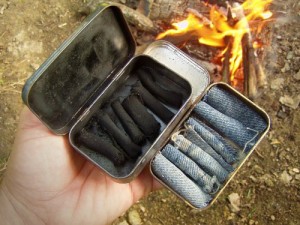 The first time that I watched fire being made by flint and steel I was amazed and intrigued. I learned that sparks alone do not equate with fire, but they need to be caught by a charred medium in order to build into a flame. Charcloth is that medium that catches sparks and is made by carbonizing a natural fiber cloth – most notably cotton.
The first time that I watched fire being made by flint and steel I was amazed and intrigued. I learned that sparks alone do not equate with fire, but they need to be caught by a charred medium in order to build into a flame. Charcloth is that medium that catches sparks and is made by carbonizing a natural fiber cloth – most notably cotton.
Carbonizing is accomplished by charring or a partial burning process. Typically small pieces of cotton (perhaps 2″ square) are placed in a covered metal container and placed over heat such as a fire or coals. The metal container must have seams or holes to release the pressure that builds up due to the gasification that occurs while the material bakes. The container prevents the material from igniting so that it is not “spent” or consumed. Different materials are popular for making charcloth: jeans, underwear, cheesecloth and gauze – all made of 100 percent cotton.
You can use small empty paint cans with a nail hole punched into the lid. The can should be turned occasionally during the baking process to evenly expose the contents inside. A very popular and portable container is an “Altoids” mint canister that is compact and requires less bake time for a finished product. I used to stack cloth squares inside these containers but battled uneven results. More recently I’ve learned to roll the cloth squares into small rolls and lay them side-by-side with very excellent results.
The general rule for cook time is to watch the emission of smoke out of the canister which should be fairly steady and when it diminishes, take the container off the heat, let cool, then open for inspection. The charred cloth should be black, not brown, and when handled should be velvety and light weight.
There is a method of making charcloth that does not require a container – it’s called “quick char” where a piece of cloth is lit directly then snuffed out once the piece turns black. There is usually enough suitable char to make a flame with tinder but baked char is thoroughly treated and even in carbon content and performs better providing that it is stored in a moisture-tight container.



rolls defeat the purpose. bake them flat to catch the spark easier later and to store more of them in a box. they are too brittle to manipulate afterwards.
Perhaps if your rolls break when unrolled they are over-baked… properly baked charcloth has enough flexibility to unroll for use.